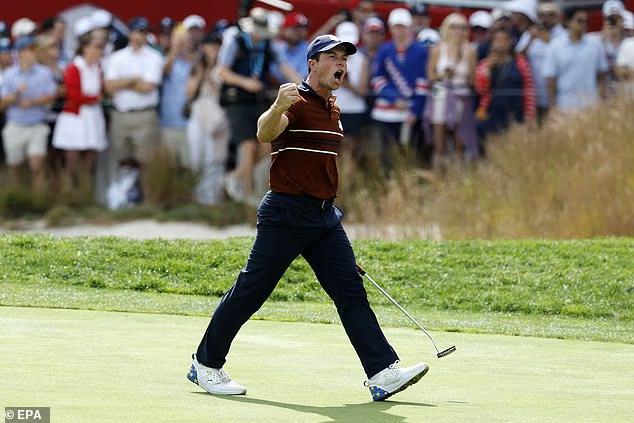Understanding the Ryder Cup’s Unique Envelope Rule: Could It Be Activated This Year?
The Ryder Cup, a cornerstone of golf competition, gears up for an exhilarating final day at Bethpage Black. As the teams prepare for the decider, a lesser-known yet pivotal rule—the Envelope Rule—could play a vital role in determining the outcome. Let’s dive into the crucial aspects of the Ryder Cup, analyze the ongoing events, and understand the importance of this enigmatic rule.
A Strong European Lead
On the second day of this year’s Ryder Cup, Team Europe displayed a powerhouse performance. Under the guidance of Captain Luke Donald, the Europeans outplayed their American counterparts, extending their lead to five points. Their dominance continued through Saturday’s foursomes, showcasing an impressive synergy among players. However, the excitement was paired with an air of uncertainty due to a recent injury.
Injury Concerns: Viktor Hovland’s Withdrawal
The momentum shifted slightly when European star Viktor Hovland was forced to withdraw from the afternoon session due to a neck injury. After delivering a stellar performance, including triumphing over world No. 1 Scottie Scheffler, Hovland’s withdrawal raised eyebrows and concern among fans and teammates alike. His partnership with Matt Fitzpatrick in the final match of the fourball sessions had been highly anticipated, highlighting the significance of his absence.
Uncertainty for Sunday’s Singles
As the competition narrows down, the focus shifts to Hovland’s condition for Sunday’s singles. While official statements on the severity of his injury remain scarce, speculation surrounds his ability to take the tee. This uncertainty opens the possibility for the rare activation of the Envelope Rule, which is designed as a contingency measure in case of player injuries.
The Envelope Rule: A Brief Overview
Since its inception in 1979, the Envelope Rule has been a point of intrigue within Ryder Cup lore. Both captains, Donald and Keegan Bradley, sealed a name from their respective teams in an envelope prior to the event. Should an unexpected injury or illness render a player unable to compete, the designated player from the envelope is replaced, effectively splitting the match points between teams.
The Envelope Rule’s Historical Context
The Envelope Rule is not without its history. It was first activated in 1991 during the Kiawah Island Ryder Cup, when European captain Bernard Gallacher was faced with the unenviable task of revealing the sealed player’s name due to rookie Steve Pate’s injury. Since then, the rule has been a rare aspect of Ryder Cup proceedings, invoked only once more in 1993 when Sam Torrance withdrew due to an injury.
The Stakes are High: What It Means for the Teams
The implications of the Envelope Rule extend beyond just match readiness; it can impact team dynamics and morale. Each captain must make an uncomfortable decision, essentially indicating whom they trust the least—a task that no sports leader takes lightly. This hidden choice heightens the tension within the teams, emphasizing the stakes involved.
A Modern-Day Scenario: What If Hovland Can’t Play?
Should Hovland remain unable to play, the anticipation of revealing the sealed envelope becomes palpable. Early reports indicated that Tyrrell Hatton was prepared as a backup, demonstrating the depth of the European roster. Consequently, seeing the name sealed within the envelope could reshape the matchups and shift the momentum.
The Rumblings of a Comeback
However, the narrative may take a turn, as recent updates suggest Hovland might indeed be fit to compete. Such news brings a sense of relief to Team Europe, underlining the unpredictability of the tournament. Fans and analysts alike are eagerly monitoring Hovland’s condition as the stakes continue to rise.
The Future of the Ryder Cup and Legacy of the Envelope Rule
As the Ryder Cup continues to captivate golf enthusiasts globally, the ongoing narratives within the tournament, including the enigmatic Envelope Rule, ensure the event remains thrilling. Whether or not the rule is activated this year, its legacy continues to shape the competition’s dynamics, reflecting the intrinsic unpredictability of this revered sporting spectacle.
Conclusion: A Historic Ryder Cup Awaits
As we await the thrilling conclusion of this year’s Ryder Cup, the focus sharpens on player readiness and team strategies. The introduction of the Envelope Rule adds an element of suspense and strategy to the competition. Regardless of the outcome, the Ryder Cup stands as a vibrant testament to the sport’s camaraderie, rivalry, and unpredictability. With the final day on the horizon, one thing is certain: history will be made, and fans won’t want to miss a moment of the action.
This article aims to optimize for search engines by incorporating relevant keywords like "Ryder Cup," "Envelope Rule," "golf competition," and "Viktor Hovland," while providing an engaging and comprehensive overview of the event and related details.


